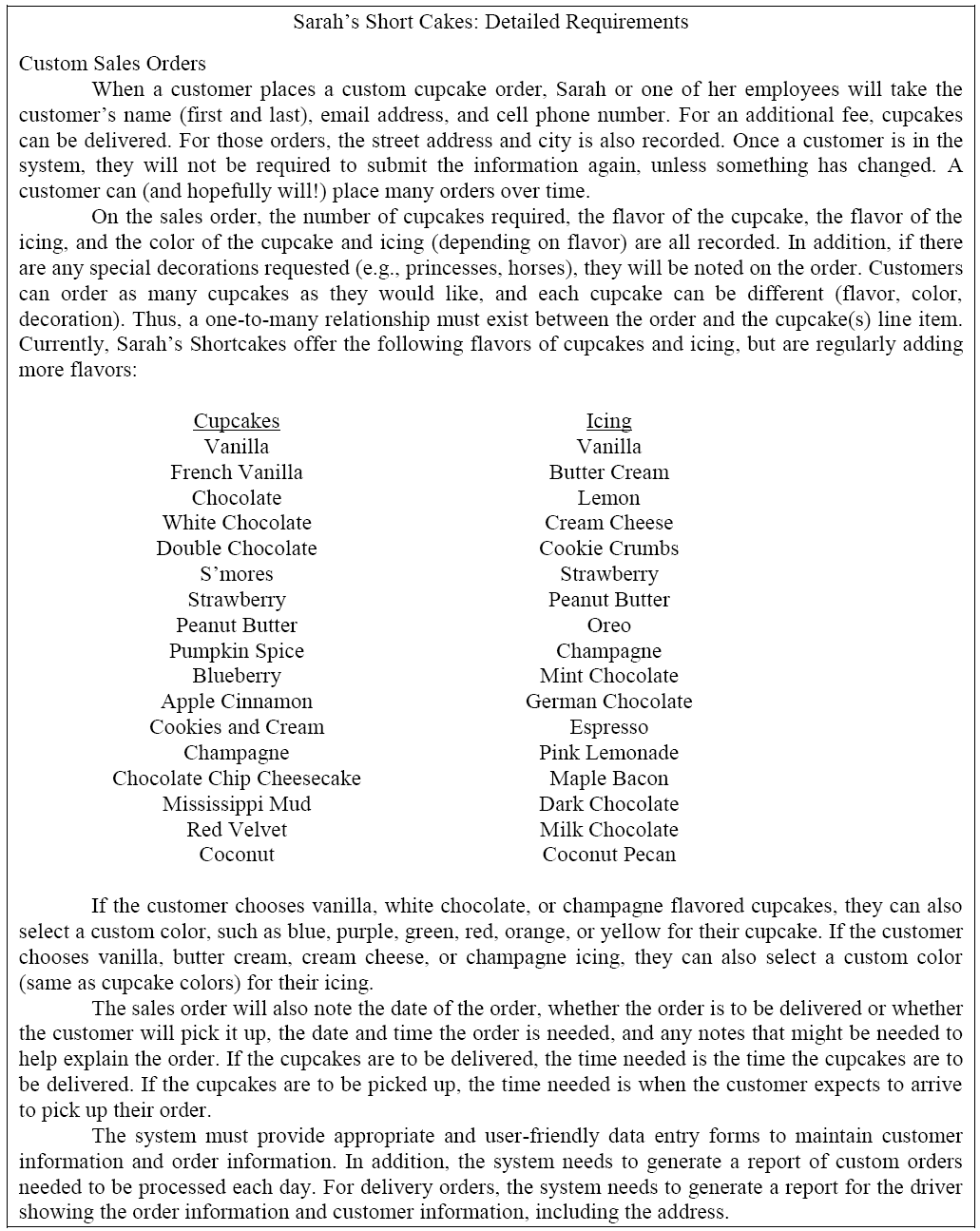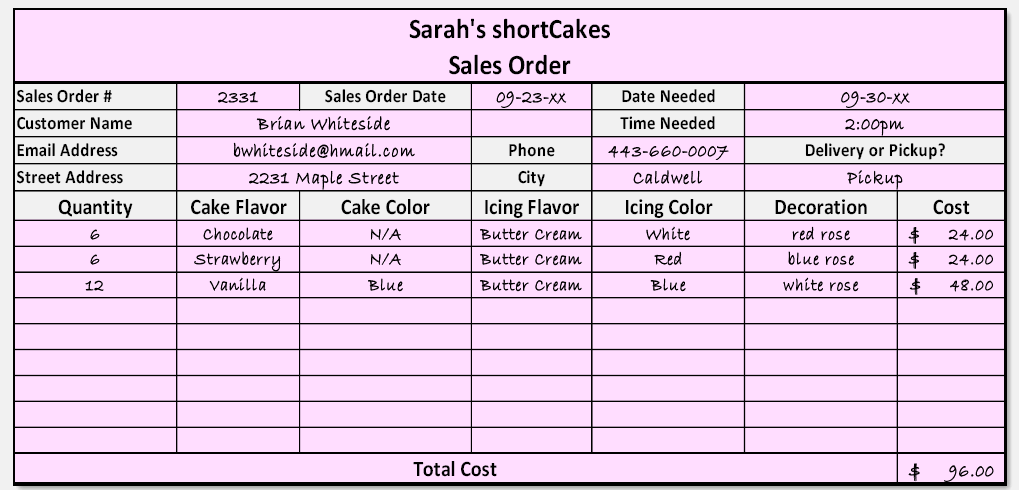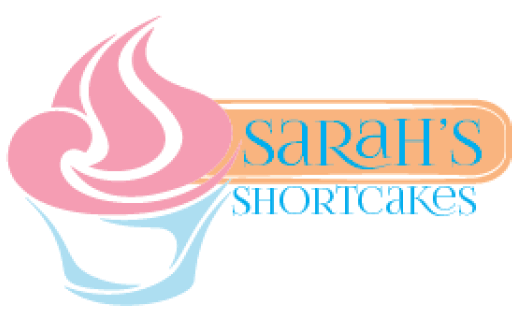Case Reports: 2017 Vol: 23 Issue: 1
Case Study : Systems Analysis, Design and Development Case Study: Sarah's Short Cakes Sales Order System
University of Mary Hardin-Baylor
Case Description
The primary purpose of this case study is for Systems Analysis and Design, Systems Development, and Database courses. Students examine realistic dialog and Interview Notes, as well as existing documents. For Systems Analysis and Design courses, the students should be able to follow this realistic and fairly common case study of a small business and conduct the planning, analysis, and design phases of the System Development Life Cycle (SDLC), using either a traditional or object-oriented approach. Deliverables would include process and data diagrams and modeling, and user interface designs, and should require approximately 12-15 hours to complete, outside normal class time. In System Development courses, e.g., capstone courses for a computer information systems major, students can use this case study to not only analyze and design a solution, but actually develop the solution using various windows or web-based tools. The entire project should require approximately 20-25 hours to complete. For Database courses, this case could be used to illustrate database design techniques, resulting in the creation of appropriate data models and physical database designs. This should require approximately 10-12 hours to complete. The case study is of moderate difficulty – ranging from a three to five, and is designed for junior and senior level students, but could also be used for graduate courses.
Case Synopsis
Dr. Thomas Waggoner, an information systems professor at the local university, is at a small bakery waiting to pick up cupcakes for his daughter’s birthday party. The lengthy and unorganized approach to waiting on customers presented Dr. Waggoner with an idea which he shared with the owner of the bakery. His students could design and build a system to help track sales orders, and hopefully help the business become more efficient. Sarah, the owner of the bakery, was very excited about the possibilities, and they decided to meet later in the week to discuss the details.
Introduction
Dr. Thomas Waggoner was number 43. The sign said currently serving number 34. All he needed to do was pick up the three dozen cupcakes his wife had ordered for their daughter’s birthday party, which was going to start in just under an hour. As Dr. Waggoner waited semi-patiently, fortunately (for him, but unfortunately for the store) one by one several potential customers got tired of waiting and left. Unfortunately, as tasty and expertly designed as Sarah’s cupcakes were, there was a significant problem with keeping everything organized. Ten minutes later, Dr. Waggoner’s number was finally called. After the clerk retrieved his cupcakes, Dr. Waggoner decided to ask if the seeming disorganization was normal.
“Is it always this busy?”
“Most days, yes. When the owner, Sarah, started the business about a year ago, she was worried whether we would have enough customers to make it work. Now, we are worried about whether we will be able to handle all the customers we have. We currently bake and sell between 80 and 100 dozen cupcakes each day. We can handle the daily sales – no problem. Every morning we make several batches of cupcakes in different flavors and with different colors of icing. These go in the display cases. We almost always sell these by the end of the day. The bigger problem is trying to keep track of the different custom orders, such as yours. And, on top of that, Sarah wants to open a second location sometime next year. I am not sure how we are going to manage all that, but fortunately that is Sarah’s concern, not mine!”
Dr. Waggoner decided to probe a little deeper, although he was also aware of the time and pending party. Since the store was actually void of customers at the moment, he asked,
“Do you have a system to help you track the orders? I actually teach several computer systems courses at the university, and I might be able to help.”
At that moment, the owner of Sarah’s Short Cakes walked in from the back room and answered Dr. Waggoner’s question.
“The answer to your question is, ‘Not really’. The answer to your offer is ‘Great!’” interjected Sarah. “I suppose have a ‘system’ but it is stored in my head. We write down the details on a sales order form so we get the orders correct, but we sometimes have trouble keeping track of how many orders we have promised for a particular day, and also in having enough of the right ingredients on hand.”
“I have to get these cupcakes home, but would you like to get together later this week so I can get a better understanding of your business? This could make a good project for my students”
“That would be great! Thanks, and tell your daughter Happy Birthday!”
Dr. Waggoner met with Sarah later that week to start understanding how her business operated (and enjoy a free cupcake!). He then asked a group of his students to contact Sarah to meet with her and develop a list of detailed requirements for a new system to help keep track of custom orders and ingredients inventory. The detailed requirements are listed below.

Dr. Waggoner explained to his analysis and design students what Sarah really needed was a database system which would maintain information about each custom order. The system should also generate daily reports on what orders need to be processed.
After gathering the detailed requirements for the system, Dr. Waggoner assigned his students the requirements shown below. His SAD students began developing data and process models and designing the user interfaces. As the semester progressed and the analysis and design phases were completed, Dr. Waggoner had his system development class use the specifications and start creating the working system. By the end of the semester the system was completed and implemented, and Sarah’s Short Cakes was able to keep track of their orders much more efficiently.
Requirements for Systems Analysis and Design Students:
1. Prepare a system proposal that includes an executive summary, the requirements of the system, and identification of your team members.
2. Develop appropriate process models (Use Case Descriptions/Diagram or Data Flow Diagrams – context level, level 0, level 1) per your professor’s instructions.
3. Develop the appropriate data model (Class Diagram or Entity-Relationship Diagram) per your professor’s instructions.
4. Develop preliminary screen and report designs for each user interface identified above, adhering to proper user interface design principles.
5. Prepare a one-page “pre-implementation review” outlining lessons learned - what went right and what went wrong on this project.
Requirements for Systems Development Students:
1. Complete the above requirements, or refer to the packet of materials provided by your professor.
2. Using Microsoft Access, Visual Basic, or other appropriate development tool, develop a comprehensive, user-friendly, working system that will meet the requirements of Sarah’s Short Cakes.
3. Prepare a user manual describing how to use the system.
4. Prepare a one-page “post-implementation review” outlining lessons learned – what went right and what went wrong on this project.
Additional Resources:
The following are addresses to YouTube videos which provide a very useful inside view of the operations of a bakery. These videos may help with your understanding of the business processes.
https://www.youtube.com/watch?v=Dim-w4rRT4c
https://www.youtube.com/watch?v=k_YEECQJoco
https://www.youtube.com/watch?v=5WRswXTW8r0
Appendix
Sales Order

Sarah’s Short Cakes Logo
